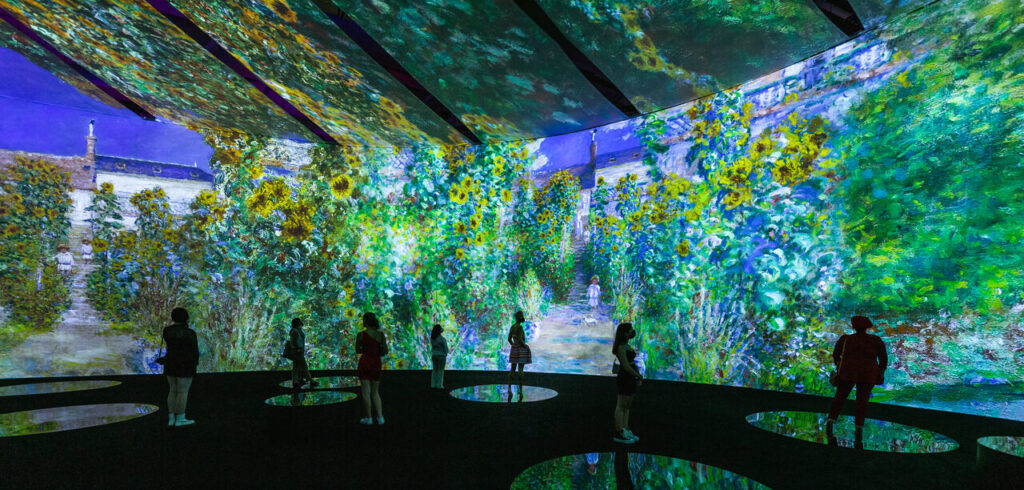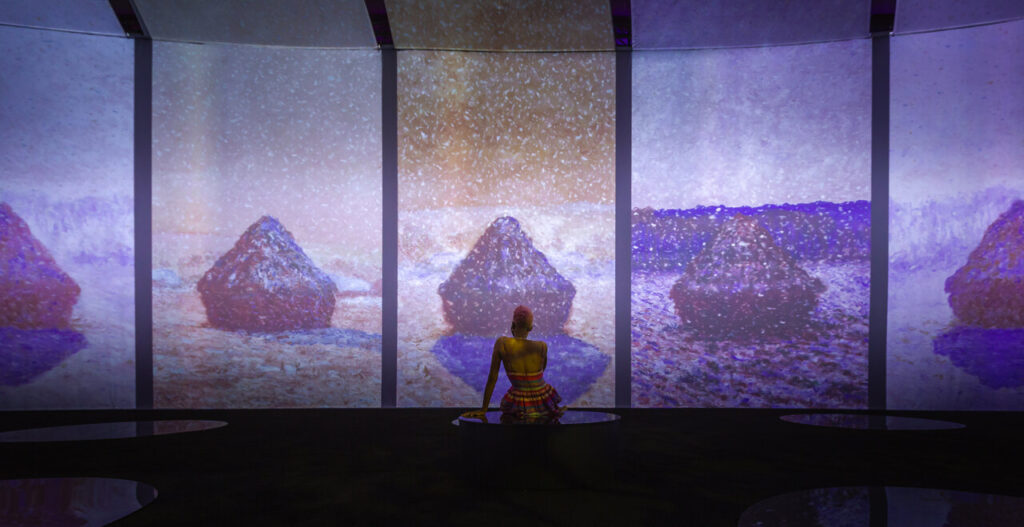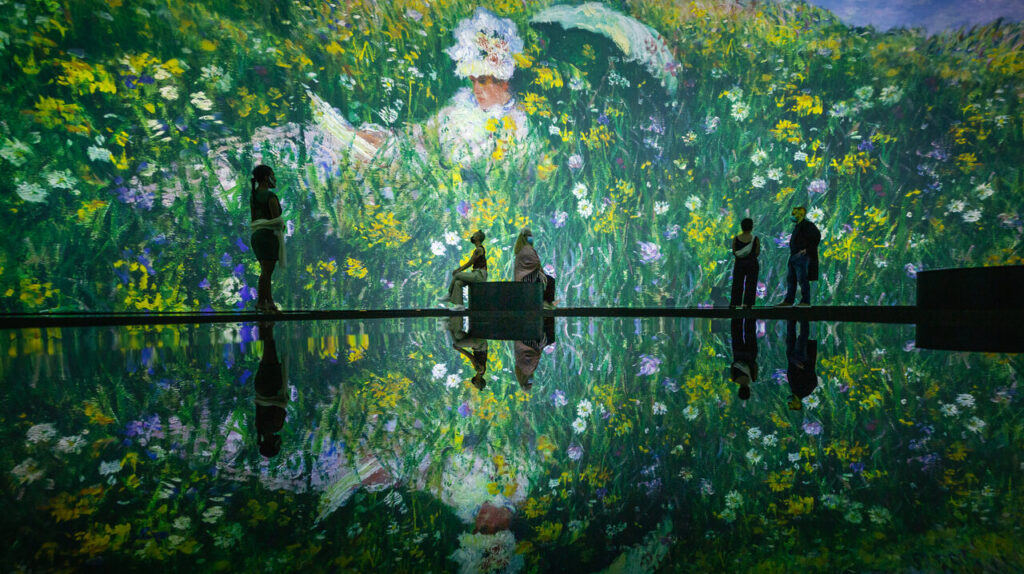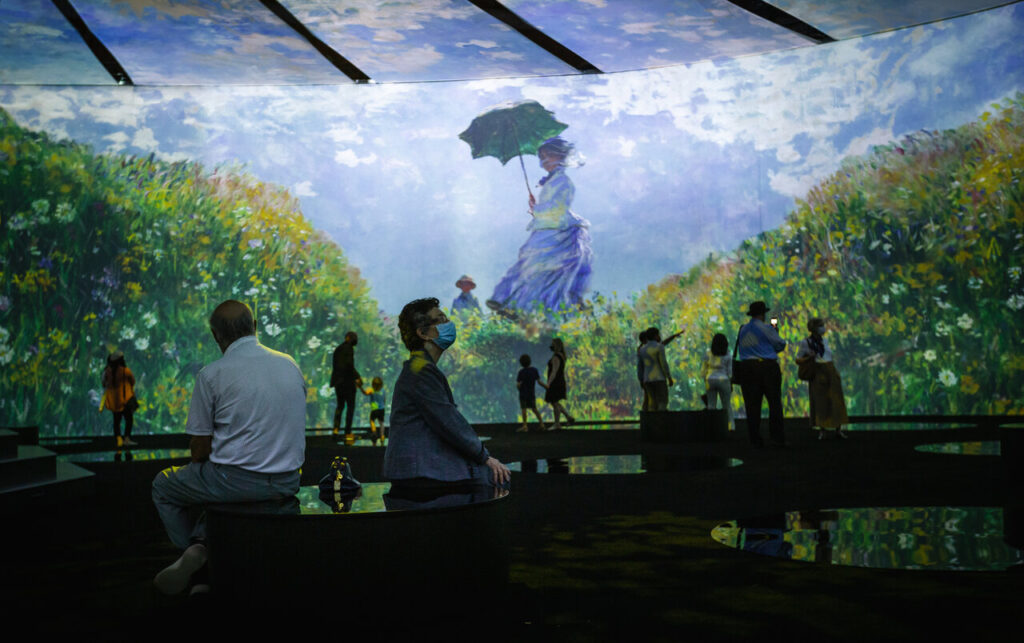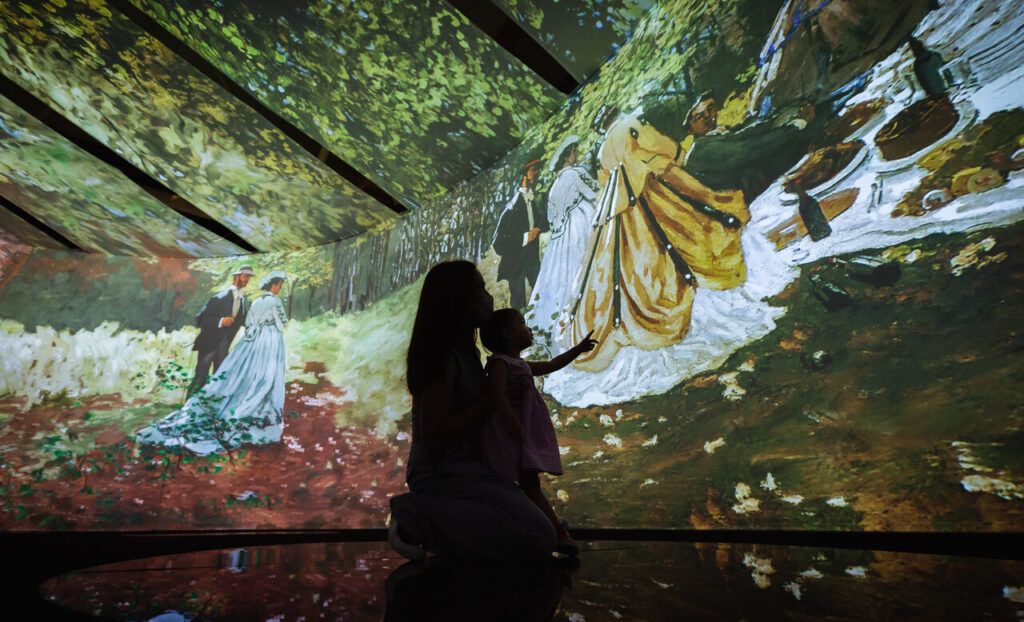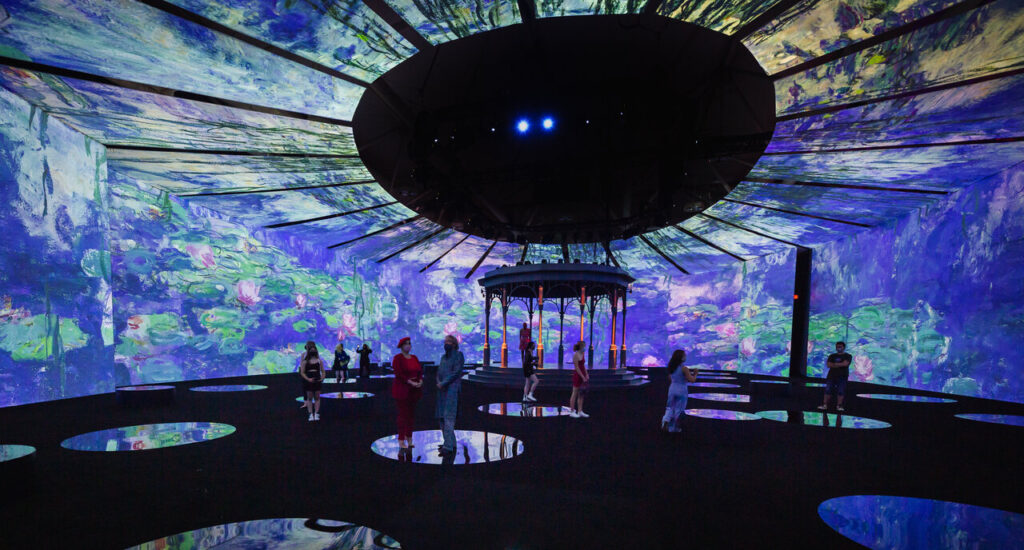There’s a new art experience in town: Beyond Monet boasts a “three parts multi-sensory experience anchored in the unbridled pursuit of light that drove this leading figure of Impressionism”. This dazzling exhibition showcases hundreds of works by renowned Impressionist Claude Monet in an immersive format: animated sequences of paintings, a recreation of Monet’s garden in Giverny, and engaging music and sound effects. Visitors feel as if they themselves are inside a Monet painting. Combining instantly recognizable classics with the artist’s lesser-known work, the show brings viewers on a captivating, unique tour of the artist’s magical, iconic oeuvre.
The entrance of the exhibition is designed to mimic Monet’s garden, with hanging florals and bridges suspended over reflective “pools”. Entering this room felt like stepping into one of Monet’s Water Lily Pond paintings.
As you walk through the corridor leading you to the next room, the color and light changes around you, capturing the effervescent, ephemeral quality of Monet’s paintings.
The final room has a panoramic projection of Monet’s paintings in an animated sequence. One can sit in the pavilion at the centre of the room and watch the paintings move and change around them.
Bronwen Cox spoke with Fanny Curtat, Art History Consultant, about the behind-the-scenes process of Beyond Monet.
Fanny Curtat, Art History Consultant at Beyond Monet
BC: How did you decide to create an exhibition in this format? How did the concept first originate?
FC: This is the second time we’re taking a crack at this type of exhibit. These kinds of shows have been going on for at least a decade, and I think it’s gaining steam. It’s a great way to immerse the audience, and provide a different access point into the art world for people who might think museums are intimidating. This is a great opportunity to bridge different experiences of the art world. Not necessarily in opposition to a museum; for me, it’s a complimentary experience. People might be hesitant to go to a museum, but here, they may develop a connection with Monet. Next time they’re in a museum, they might be curious to see the original artwork, and enjoy its aura. These experiences have a lot going for them. Especially now, with the pandemic, it’s a great way to see something and be part of a cultural event, while still being spaced out and taking all the precautions.
When we created the original Van Gogh exhibition it was during the pandemic. It was very much in the back of our minds to be able to provide an experience for people to have some sense of relief, and to be inspired by artists. Both Van Gogh and Monet, went through struggles and incredible hardship, but that doesn’t show up in their art.
BC: In what ways do interactive exhibits allow people to engage with art that traditional museums can not? What are the main advantages and disadvantages of this exhibition format?
FC: The main disadvantage is not having the object, the original painting, not being surrounded by its aura, or able to feel its energy, see the texture and the brushstrokes. What we do have is a great tool to animate the works, to combine many artworks that we couldn’t afford to have in one room. We have over 400 in this exhibition. These experiences allow the audience to see themselves in the art; instead of going toward the artwork, it’s coming toward you. That’s the way it’s helping to bridge that gap between a 19th century body of work and a 21st century audience. It’s also providing a very good experience for visitors to share on social media. They can really be in it.
BC: How has the pandemic affected this process?
FC: This is actually the first time I’ve met the team! We’ve been working remotely. The pandemic also affected the presentation format. That’s why the first room, the garden, is meant to be really spread out, like a true garden where you can just wander around and have your own space.
BC: Did you come across any difficulties that weren’t COVID-related, that you didn’t expect?
FC: There are a lot of artworks. Monet painted over 2000 oil paintings. Getting through them, accessing high-quality reproductions, getting the rights for them, and the right colors — balancing all of this was a gauntlet. It was worth it, and we knew we were getting into a very prolific body of work, but once you’re in it, you realize there’s so much to choose from. It was a great opportunity but also very challenging.
BC: What drew you to Van Gogh and Monet as artists? Since they’re both Impressionists, or Post-impressionists, what was it about that style that drew you to these artists and periods?
FC: Actually, it’s called Beyond Monet because it’s about going beyond that notoriety. In the case of Van Gogh it’s about going beyond the darkness of the myth. People know more about the ear-cutting incident than his work itself, which shows none of the darkness we attribute to his life. It’s there, but that’s not what he wanted to show us. With Monet, we sort of have this ease with his work. We are so accustomed to it: it’s so beautiful and easily accessible that we forget how radical he was, the sense of freedom in his work, the non-conformism and self-expression, and the pure subjectivity that’s imbued in all his work. Both of them are also easy to animate, because they are already so animated themselves — the brushstrokes, the colors — which are not blended but juxtaposed. All of this is very dynamic, so it’s a very easy fit.
Bronwen Cox
All images are titled, Installation view of Beyond Monet, 2021 and courtesy of Beyond Monet
*Exhibition information: Beyond Monet, August, 2021 – February 6, 2022, Metro Toronto Convention Centre, North Building, 255 Front St W, Toronto. Exhibition hours: Sun – Thurs 10am – 10pm, Fri – Sat 10am – 11pm.

